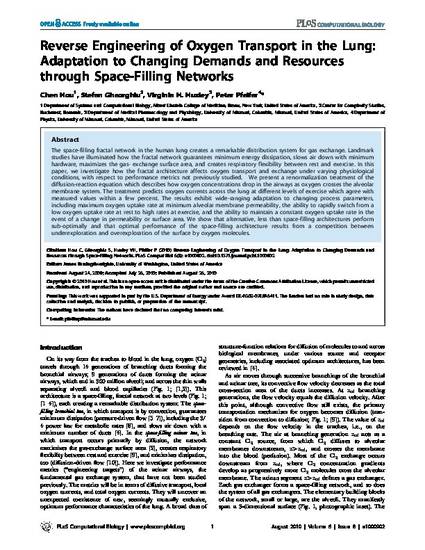
The space-filling fractal network in the human lung creates a remarkable distribution system for gas exchange. Landmark studies have illuminated how the fractal network guarantees minimum energy dissipation, slows air down with minimum hardware, maximizes the gas- exchange surface area, and creates respiratory flexibility between rest and exercise. In this paper, we investigate how the fractal architecture affects oxygen transport and exchange under varying physiological conditions, with respect to performance metrics not previously studied. We present a renormalization treatment of the diffusion-reaction equation which describes how oxygen concentrations drop in the airways as oxygen crosses the alveolar membrane system. The treatment predicts oxygen currents across the lung at different levels of exercise which agree with measured values within a few percent. The results exhibit wide-ranging adaptation to changing process parameters, including maximum oxygen uptake rate at minimum alveolar membrane permeability, the ability to rapidly switch from a low oxygen uptake rate at rest to high rates at exercise, and the ability to maintain a constant oxygen uptake rate in the event of a change in permeability or surface area. We show that alternative, less than space-filling architectures perform sub-optimally and that optimal performance of the space-filling architecture results from a competition between underexploration and overexploration of the surface by oxygen molecules.
- Adaptation,
- Airway Dynamics,
- Article,
- Bioengineering,
- Breathing Exercise,
- Breathing Rate,
- Controlled Study,
- Lung Alveolus Oxygen Tension,
- Lung Alveolus Surface Tension,
- Lung Diffusion Capacity,
- Lung Flow Volume Curve,
- Lung Gas Exchange,
- Lung Model,
- Lung Structure,
- Lung Ventilation Distribution,
- Mathematical Computing,
- Membrane Permeability,
- Oxygen Affinity,
- Oxygen Concentration,
- Oxygen Consumption,
- Oxygen Diffusion,
- Oxygen Transport,
- Physiological Process,
- Prediction, Adaptation, Physiological,
- Cell Membrane Permeability,
- Diffusion,
- Exercise,
- Fractals,
- Humans,
- Lung,
- Models, Biological,
- Oxygen,
- Pulmonary Alveoli,
- Pulmonary Gas Exchange
Available at: http://works.bepress.com/chen-hou/19/
